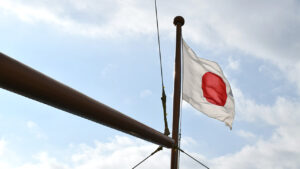TOKYO — Japan said it has asked the United States (US) to suspend all nonemergency V-22 Osprey flights over its territory after one fell into the sea on Wednesday in western Japan, marking the country’s first fatal US military plane crash in five years.
The US Air Force, which was operating the tilt-rotor aircraft, said the cause of the mishap, which killed at least one person, is unknown. The condition of the other seven people on board was not known. “The occurrence of such an accident causes great anxiety to the people of the region… and we are requesting the US side to conduct flights of Ospreys deployed in Japan after these flights are confirmed to be safe,” Minoru Kihara said in Parliament on Thursday, reversing a decision yesterday to allow such flights to continue.
The Japan Self-Defense Forces (SDF), which also operates Ospreys, will suspend flights of the transport aircraft until the circumstances of the incident are clarified, another senior defense ministry official said in parliament.
A spokesperson for U S military forces in Japan did not immediately respond to a request for comment.
Witnesses said the aircraft’s left engine appeared to be on fire as it approached an airport for an emergency landing in clear weather and light winds, media reported.
Developed by Boeing and Bell Helicopter, the hybrid V-22, which can land and take off like a helicopter and fly like a fixed-wing aircraft, is operated by the U S Air Force, Marines and Navy, and the SDF.
The deployment of the aircraft in Japan has been controversial, with critics of the U S military presence in the southwest islands saying it is prone to accidents. The U S and Japan say it is safe.
Japan hosts the biggest overseas concentration of U S military power, with the country home to the only forward-deployed U S carrier strike group, its Asian airlift hub, fighter squadrons and a U S Marine Corps expeditionary force.
In August, a U S Osprey crashed off the coast of northern Australia while transporting troops during a routine military exercise, killing three U S Marines.
Another crash-landed in the ocean off the southern island of Okinawa in December 2016, the first such incident in Japan, prompting a temporary U S military grounding of the aircraft.
The last fatal U S military aircraft crash in Japan was 2018, when a mid-air collision during a training exercise killed six people, according to the defense ministry. — Reuters

